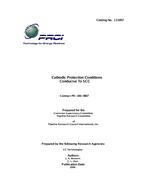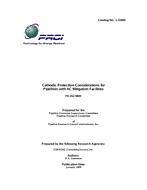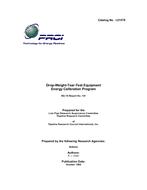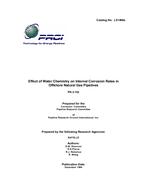Provide PDF Format
PRCI PR-186-9807
- Cathodic Protection Conditions Conductive to SCC
- Report / Survey by Pipeline Research Council International, 01/01/2001
- Publisher: PRCI
$348.00$695.00
L51897e
CC Technologies Laboratories, Inc.
Need: The 100 mV polarization criterion is commonly used to verify cathodic protection (CP) on older, poorly coated, pipelines where the -850 mV criterion is difficult to achieve. NACE RP 01-69 and Canadian Recommended Practice OCC-1 caution against using polarized potentials less negative than -850 or -770 mV, respectively, where other conditions may be conducive to external stress corrosion cracking (SCC). The cautionary statement is based on research, which suggests that application of the 100 mV polarization criterion can promote one form of SCC, referred to as high-pH or classical SCC. However, this research has not been developed to the point of being able to provide guidance to pipeline operators.
Result: The objective of this research project was to define pipeline conditions where use of the 100 mV polarization criterion may be conducive to possible SCC problems. Each of the controlling conditions for the two recognized forms of SCC (high pH SCC and near neutral pH SCC) was examined, using a combination of analysis of previous research results, analysis of unpublished field data, and laboratory testing. In the original proposal, it was not planned to analyze field data but the data became available and the analysis has yielded some significant findings. The results of the literature survey, the analysis of the soil and electrolyte data from the SCC field digs, and the testing performed in this project all indicate that cathodic protection is generally beneficial in mitigating near-neutral pH SCC. Furthermore, the only testing reported in the literature, which suggests that cathodic protection is detrimental to this form of cracking, was performed under unrealistic conditions where cathodic polarization was applied to pipe steel samples containing growing cracks, but the beneficial environmental polarization that accompanies cathodic protection was not allowed to occur. One conclusion from this current research is that it is not necessary to consider the near neutral pH form of cracking in the selection of the CP criterion.
Benefit: A deliverable for this project is a protocol that a pipeline operator can use to identify those portions of the pipeline system where the 100 mV polarization criterion can be safely used and those portions where use of the criterion may promote SCC. The nature of this deliverable limits the parameters that can be included in the protocol to those that are available to a pipeline operator. Therefore, parameters such as electrolyte composition (from beneath a disbonded coating) may be useful in the data analysis process but cannot be included in the protocol. A flow diagram was used to organize the protocol and the diagram contains the following parameters; Coating Type, Surface Condition, Operating Stress, Operating Temperature, and Soluble Cation Concentration of the Soil as the decision blocks.
CC Technologies Laboratories, Inc.
Need: The 100 mV polarization criterion is commonly used to verify cathodic protection (CP) on older, poorly coated, pipelines where the -850 mV criterion is difficult to achieve. NACE RP 01-69 and Canadian Recommended Practice OCC-1 caution against using polarized potentials less negative than -850 or -770 mV, respectively, where other conditions may be conducive to external stress corrosion cracking (SCC). The cautionary statement is based on research, which suggests that application of the 100 mV polarization criterion can promote one form of SCC, referred to as high-pH or classical SCC. However, this research has not been developed to the point of being able to provide guidance to pipeline operators.
Result: The objective of this research project was to define pipeline conditions where use of the 100 mV polarization criterion may be conducive to possible SCC problems. Each of the controlling conditions for the two recognized forms of SCC (high pH SCC and near neutral pH SCC) was examined, using a combination of analysis of previous research results, analysis of unpublished field data, and laboratory testing. In the original proposal, it was not planned to analyze field data but the data became available and the analysis has yielded some significant findings. The results of the literature survey, the analysis of the soil and electrolyte data from the SCC field digs, and the testing performed in this project all indicate that cathodic protection is generally beneficial in mitigating near-neutral pH SCC. Furthermore, the only testing reported in the literature, which suggests that cathodic protection is detrimental to this form of cracking, was performed under unrealistic conditions where cathodic polarization was applied to pipe steel samples containing growing cracks, but the beneficial environmental polarization that accompanies cathodic protection was not allowed to occur. One conclusion from this current research is that it is not necessary to consider the near neutral pH form of cracking in the selection of the CP criterion.
Benefit: A deliverable for this project is a protocol that a pipeline operator can use to identify those portions of the pipeline system where the 100 mV polarization criterion can be safely used and those portions where use of the criterion may promote SCC. The nature of this deliverable limits the parameters that can be included in the protocol to those that are available to a pipeline operator. Therefore, parameters such as electrolyte composition (from beneath a disbonded coating) may be useful in the data analysis process but cannot be included in the protocol. A flow diagram was used to organize the protocol and the diagram contains the following parameters; Coating Type, Surface Condition, Operating Stress, Operating Temperature, and Soluble Cation Concentration of the Soil as the decision blocks.
Related Products
PRCI PR-262-9809
Cathodic Protection Considerations for Pipelines w/AC Mitigation Facilities..
$298.00 $595.00
PRCI PR-3-152
Effects of Water Chemistry on Internal Corrosion Rates in Offshore Natural Gas Pipelines..
$148.00 $295.00





